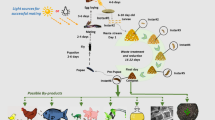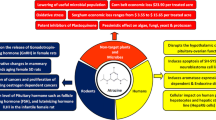Abstract
Today, pest control by chemical treatment is the main strategy against pest insects. This article proposes to show how cyclic voltammetry of immobilized particles could be applied in the context of pest research by screening several compounds known to have an activity against a pest model as Aedes species. Aedes mosquitoes are vectors of many diseases that represent a threat to humans such as yellow fever and dengue fever in tropical environments. In order to develop innovative screening approaches for new pesticides, we search molecules that can interact potentially with a pest model (Aedes species). We characterized electrochemically the mosquitoes using voltammetry of immobilized particles (VIMP) method and analyze modifications on its characteristic signals in contact of insecticides.







Similar content being viewed by others
References
World Health Organization (2020) Vector-borne diseases. https://www.who.int/news-room/fact-sheets/detail/vector-borne-diseases
World Health Organization (2021) Malaria. https://www.who.int/news-room/fact-sheets/detail/malaria
World Health Organization (2019) Yellow fever. https://www.who.int/news-room/fact-sheets/detail/yellow-fever
World Health Organization (2021) Dengue and severe dengue. https://www.who.int/news-room/fact-sheets/detail/dengue-and-severe-dengue
Yang L, Norris EJ, Jiang S et al (2020) Reduced effectiveness of repellents in a pyrethroid-resistant strain of Aedes aegypti (Diptera: Culicidae) and its correlation with olfactory sensitivity. Pest Manag Sci 76:118–124. https://doi.org/10.1002/ps.5562
Deng Y, Yan H, Gu J et al (2013) Molecular and functional characterization of odorant-binding protein genes in an invasive vector mosquito, Aedes albopictus. PLoS ONE 8:e68836. https://doi.org/10.1371/journal.pone.0068836
Lu D, Lu F, Geng L, Pang G (2018) Recent advances in olfactory receptor (OR) biosensors and cell signaling cascade amplification systems. Sensors Materials 30:67. https://doi.org/10.18494/SAM.2018.1607
Leal WS (2013) Odorant reception in insects: roles of receptors, binding proteins, and degrading enzymes. Annu Rev Entomol 58:373–391. https://doi.org/10.1146/annurev-ento-120811-153635
Tchouassi DP, Jacob JW, Ogola EO et al (2019) Aedes vector–host olfactory interactions in sylvatic and domestic dengue transmission environments. Proc R Soc B 286:20192136. https://doi.org/10.1098/rspb.2019.2136
Sung JH, Ko HJ, Park TH (2006) Piezoelectric biosensor using olfactory receptor protein expressed in Escherichia coli. Biosens Bioelectron 21:1981–1986. https://doi.org/10.1016/j.bios.2005.10.002
Bohbot JD, Vernick S (2020) The emergence of insect odorant receptor-based biosensors. Biosensors 10:26. https://doi.org/10.3390/bios10030026
Cheema JA, Aydemir N, Carraher C et al (2021) Insect odorant receptor nanodiscs for sensitive and specific electrochemical detection of odorant compounds. Sens Actuators B Chem 329:129243. https://doi.org/10.1016/j.snb.2020.129243
Szunerits S, Boukherroub R, Vasilescu A (2020) Electrochemical biosensing with odorant binding proteins. In: Methods in enzymology. Elsevier, pp 345–369
Khadka R, Aydemir N, Carraher C et al (2019) An ultrasensitive electrochemical impedance-based biosensor using insect odorant receptors to detect odorants. Biosens Bioelectron 126:207–213. https://doi.org/10.1016/j.bios.2018.10.043
Afify A, Horlacher B, Roller J, Galizia CG (2014) Different repellents for Aedes aegypti against blood-feeding and oviposition. PLoS ONE 9:e103765. https://doi.org/10.1371/journal.pone.0103765
Stanczyk NM, Brookfield JFY, Ignell R et al (2010) Behavioral insensitivity to DEET in Aedes aegypti is a genetically determined trait residing in changes in sensillum function. Proc Natl Acad Sci 107:8575–8580. https://doi.org/10.1073/pnas.1001313107
Stanczyk NM, Brookfield JFY, Field LM, Logan JG (2013) Aedes aegypti mosquitoes exhibit decreased repellency by DEET following previous exposure. PLoS ONE 8:e54438. https://doi.org/10.1371/journal.pone.0054438
Nentwig G, Frohberger S, Sonneck R (2017) Evaluation of clove oil, icaridin, and transfluthrin for spatial repellent effects in three tests systems against the Aedes aegypti (Diptera: Culicidae). J Med Entomol 54:150–158. https://doi.org/10.1093/jme/tjw129
Tavares M, da Silva MRM, de Siqueira LBDO et al (2018) Trends in insect repellent formulations: a review. Int J Pharm 539:190–209. https://doi.org/10.1016/j.ijpharm.2018.01.046
Gomes Fernandes MR, Cruz Lopes L, Suguimoto Iwami R et al (2021) Efficacy and safety of repellents marketed in Brazil against bites from Aedes aegypti and Aedes albopictus: a systematic review. Travel Med Infect Dis 44:102179. https://doi.org/10.1016/j.tmaid.2021.102179
Wang F, Delannay C, Goindin D et al (2019) Cartography of odor chemicals in the dengue vector mosquito (Aedes aegypti L., Diptera/Culicidae). Sci Rep 9:8510. https://doi.org/10.1038/s41598-019-44851-7
Xu P, Zhu F, Buss GK, Leal WS (2015) 1-Octen-3-ol – the attractant that repels. F1000Res 4:156. https://doi.org/10.12688/f1000research.6646.1
Boullis A, Mulatier M, Delannay C et al (2021) Behavioural and antennal responses of Aedes aegypti (l.) (Diptera: Culicidae) gravid females to chemical cues from conspecific larvae. PLoS ONE 16:e0247657. https://doi.org/10.1371/journal.pone.0247657
Bohbot JD, Durand NF, Vinyard BT, Dickens JC (2013) Functional development of the octenol response in Aedes aegypti. Front Physiol 4:. https://doi.org/10.3389/fphys.2013.00039
Paluch G, Bartholomay L, Coats J (2010) Mosquito repellents: a review of chemical structure diversity and olfaction. Pest Manag Sci 66:925–935. https://doi.org/10.1002/ps.1974
Nyasembe VO, Tchouassi DP, Pirk CWW et al (2018) Host plant forensics and olfactory-based detection in Afro-tropical mosquito disease vectors. PLoS Negl Trop Dis 12:e0006185. https://doi.org/10.1371/journal.pntd.0006185
Scholz F, Nitschke L, Henrion G, Damaschun F (1989) Abrasive stripping voltammetry — the electrochemical spectroscopy for solid state: application for mineral analysis. Z Anal Chem 335:189–194. https://doi.org/10.1007/BF00522248
Scholz F, Nitschke L, Henrion G (1989) Identification of solid materials with a new electrochemical technique — the abrasive stripping analysis. Z Anal Chem 334:56–58. https://doi.org/10.1007/BF00481974
Scholz F, Nitschke L, Henrion G (1989) A new procedure for fast electrochemical analysis of solid materials. Naturwissenschaften 76:71–72. https://doi.org/10.1007/BF00396709
Scholz F, Nitschke L, Henrion G, Damaschun F (1989) A technique to study the electrochemistry of minerals. Naturwissenschaften 76:167–168. https://doi.org/10.1007/BF00366398
da Silveira GD, Bressan LP, Schmidt MEP et al (2020) Electrochemical behavior of 5-type phosphodiesterase inhibitory drugs in solid state by voltammetry of immobilized microparticles. J Solid State Electrochem 24:1999–2010. https://doi.org/10.1007/s10008-020-04533-1
Doménech-Carbó A, Cebrián-Torrejón G, Lopes-Souto A et al (2015) Electrochemical ecology: VIMP monitoring of plant defense against external stressors. RSC Adv 5:61006–61011. https://doi.org/10.1039/C5RA11336A
Durigon AMM, da Silveira GD, Sokal FR et al (2020) Food dyes screening using electrochemistry approach in solid state: the case of sunset yellow dye electrochemical behavior. J Solid State Electrochem 24:2907–2921. https://doi.org/10.1007/s10008-020-04678-z
da Silveira GD, Di Turo F, Dias D, da Silva JAF (2020) Electrochemical analysis of organic compounds in solid-state: applications of voltammetry of immobilized microparticles in bioanalysis and cultural heritage science. J Solid State Electrochem 24:2633–2652. https://doi.org/10.1007/s10008-020-04720-0
Doménech-Carbó A (2020) Voltammetry of immobilized particles for the future. J Solid State Electrochem 24:2063–2065. https://doi.org/10.1007/s10008-020-04562-w
Inzelt G (2002) Cyclic voltammetry of solid diphenylamine crystals immobilized on an electrode surface and in the presence of an aqueous solution. J Solid State Electrochem 6:265–271. https://doi.org/10.1007/s100080100223
Anusha JR, Kim BC, Yu K-H, Raj CJ (2019) Electrochemical biosensing of mosquito-borne viral disease, dengue: a review. Biosen Bioelectron 142:111511. https://doi.org/10.1016/j.bios.2019.111511
Sawyer DT, Chiericato G, Angelis CT et al (1982) Effects of media and electrode materials on the electrochemical reduction of dioxygen. Anal Chem 54:1720–1724. https://doi.org/10.1021/ac00248a014
Cofre P, Sawyer DT (1986) Electrochemical reduction of dioxygen to perhydroxyl (HO2.cntdot.) in aprotic solvents that contain Broensted acids. Anal Chem 58:1057–1062. https://doi.org/10.1021/ac00297a017
Jiang M, Li L, Zhu D et al (2014) Oxygen reduction in the nanocage of metal–organic frameworks with an electron transfer mediator. J Mater Chem A 2:5323–5329. https://doi.org/10.1039/C3TA15319C
El-Deab MS, Okajima T, Ohsaka T (2003) Electrochemical reduction of oxygen on gold nanoparticle-electrodeposited glassy carbon electrodes. J Electrochem Soc 150:A851. https://doi.org/10.1149/1.1574806
Qu J, Shen Y, Qu X, Dong S (2004) Preparation of hybrid thin film modified carbon nanotubes on glassy carbon electrode and its electrocatalysis for oxygen reduction. Chem Commun 34–35. https://doi.org/10.1039/B311038A
Cebrián-Torrejón G, Doménech-Carbó A, Scotti MT et al (2015) Experimental and theoretical study of possible correlation between the electrochemistry of canthin-6-one and the anti-proliferative activity against human cancer stem cells. J Mol Struct 1102:242–246. https://doi.org/10.1016/j.molstruc.2015.08.042
Oldham KB (1998) Voltammetry at a three-phase junction. J Solid State Electrochem 2:367–377. https://doi.org/10.1007/s100080050113
Lovrić M, Scholz F (1997) A model for the propagation of a redox reaction through microcrystals. J Solid State Electrochem 1:108–113. https://doi.org/10.1007/s100080050030
Klatt LN, Rouseff RL (1972) Electrochemical reduction of pyrazine in aqueous media. J Am Chem Soc 94:7295–7304. https://doi.org/10.1021/ja00776a009
Brolo AG, Irish DE (1997) SERS study of the electrochemical reduction of pyrazine on a silver electrode. Faraday Trans 93:419–423. https://doi.org/10.1039/a605416a
Wang R, Okajima T, Kitamura F et al (2004) Catalytic reduction of O2 by pyrazine derivatives. J Phys Chem A 108:1891–1899. https://doi.org/10.1021/jp036024k
Doménech A, Doménech-Carbó MT, de Agredos V, Pascual ML (2007) Indigo/dehydroindigo/palygorskite complex in Maya blue: an electrochemical approach. J Phys Chem C 111:4585–4595. https://doi.org/10.1021/jp067369g
Woolfson A, Rothschild M (1990) Speculating about pyrazines. Proc R Soc Lond B 242:113–119. https://doi.org/10.1098/rspb.1990.0113
Chin DH, Chiericato G, Nanni EJ, Sawyer DT (1982) Proton-induced disproportionation of superoxide ion in aprotic media. J Am Chem Soc 104:1296–1299. https://doi.org/10.1021/ja00369a025
Iguchi K, Okumura N, Usui S et al (2001) Myristoleic acid, a cytotoxic component in the extract from Serenoa repens, induces apoptosis and necrosis in human prostatic LNCaP cells. Prostate 47:59–65. https://doi.org/10.1002/pros.1047
Crow JA, Herring KL, Xie S et al (2010) Inhibition of carboxylesterase activity of THP1 monocytes/macrophages and recombinant human carboxylesterase 1 by oxysterols and fatty acids. Biochim Biophys Acta Mol Cell Biol Lipids 1801:31–41. https://doi.org/10.1016/j.bbalip.2009.09.002
Acknowledgements
Research ProJet funded by Interreg Caraïbes program (Projet CARIBPHLORE). This work was realized with the help of Anubis Vega-Rùa and Margaux Mulatier (Laboratory of Vector Control Research, Institute Pasteur of Guadeloupe), who supply the mosquitoes and the molecules tested during this research and contribute to the discussion of the results.
Author information
Authors and Affiliations
Corresponding author
Additional information
Publisher's Note
Springer Nature remains neutral with regard to jurisdictional claims in published maps and institutional affiliations.
Supplementary Information
Below is the link to the electronic supplementary material.
Rights and permissions
Springer Nature or its licensor (e.g. a society or other partner) holds exclusive rights to this article under a publishing agreement with the author(s) or other rightsholder(s); author self-archiving of the accepted manuscript version of this article is solely governed by the terms of such publishing agreement and applicable law.
About this article
Cite this article
Farouil, L., Duchaudé, Y., Zozo, L. et al. Cyclic voltammetry of immobilized particles as an alternative pesticide screening method for Aedes aegypti mosquitoes. J Solid State Electrochem 27, 1249–1259 (2023). https://doi.org/10.1007/s10008-023-05398-w
Received:
Revised:
Accepted:
Published:
Issue Date:
DOI: https://doi.org/10.1007/s10008-023-05398-w




